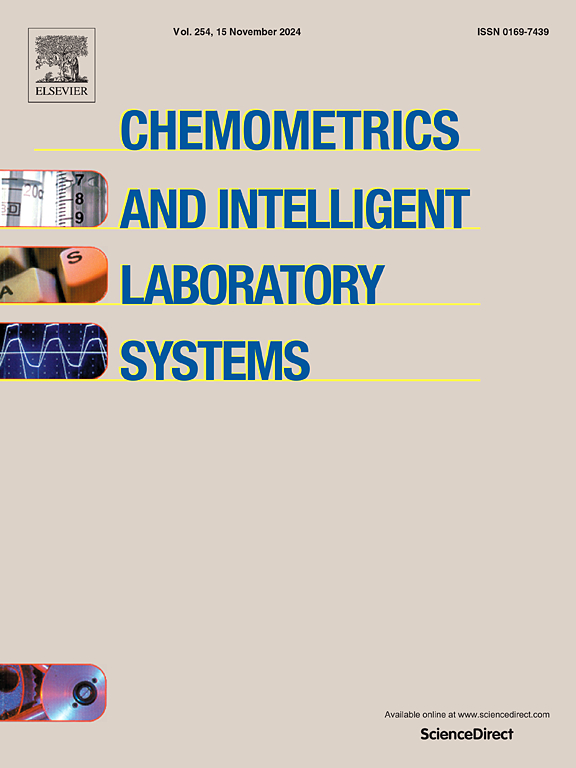Chemometric analysis of UV–visible spectral data for the differentiation of Dalbergia latifolia and Dalbergia sissoo woods
IF 3.8
2区 化学
Q2 AUTOMATION & CONTROL SYSTEMS
Chemometrics and Intelligent Laboratory Systems
Pub Date : 2025-05-30
DOI:10.1016/j.chemolab.2025.105448
引用次数: 0
Abstract
Dalbergia latifolia and Dalbergia sissoo woods are economically valuable due to their high-quality timber. However, the overexploitation of D. latifolia has led to the inclusion of D. sissoo along with D. latifolia in the CITES (Convention on International Trade in Endangered Species of Wild Fauna and Flora) list, which mandates regulated trade. Traditional wood identification methods, such as anatomical analysis, often fail to distinguish between these species. This study investigates the use of UV–visible spectroscopy combined with chemometric techniques - specifically principal component analysis (PCA), partial least square discriminant analysis (PLS-DA) and linear discriminant analysis (LDA) for the rapid and accurate differentiation of these two species. UV–visible spectral analysis of methanol extracts revealed distinct absorption peaks that facilitated the differentiation. The PCA, PLS-DA and LDA models demonstrated the effectiveness of this approach in distinguishing the two species' woods. This method offers a promising alternative for these Dalbergia species differentiation, providing a balance between speed, cost, and reliability. It is particularly valuable in situations where DNA barcoding or other high-precision techniques are impractical. The findings highlight the potential of UV–visible spectroscopy combined with multivariate analysis for timber differentiation and trade monitoring, contributing to conservation efforts.

黄檀和黄檀木材紫外可见光谱鉴别的化学计量学分析
黄檀和黄檀因其高质量的木材而具有经济价值。然而,由于对大戟叶的过度开发,大戟叶连同大戟叶一起被列入了CITES(濒危野生动植物种国际贸易公约)名单,该公约要求对贸易进行监管。传统的木材鉴定方法,如解剖分析,往往无法区分这些物种。本研究将紫外-可见光谱技术与化学计量学技术相结合,特别是主成分分析(PCA)、偏最小二乘判别分析(PLS-DA)和线性判别分析(LDA),以快速准确地区分这两种植物。甲醇提取物的紫外可见光谱分析显示有明显的吸收峰,便于鉴别。PCA、PLS-DA和LDA模型验证了该方法对两种树种林木的有效区分。该方法在速度、成本和可靠性之间取得了平衡,为黄檀的物种分化提供了一种有希望的替代方法。在DNA条形码或其他高精度技术不切实际的情况下,它特别有价值。研究结果强调了uv -可见光光谱与木材分化和贸易监测的多元分析相结合的潜力,有助于保护工作。
本文章由计算机程序翻译,如有差异,请以英文原文为准。
求助全文
约1分钟内获得全文
求助全文
来源期刊
CiteScore
7.50
自引率
7.70%
发文量
169
审稿时长
3.4 months
期刊介绍:
Chemometrics and Intelligent Laboratory Systems publishes original research papers, short communications, reviews, tutorials and Original Software Publications reporting on development of novel statistical, mathematical, or computer techniques in Chemistry and related disciplines.
Chemometrics is the chemical discipline that uses mathematical and statistical methods to design or select optimal procedures and experiments, and to provide maximum chemical information by analysing chemical data.
The journal deals with the following topics:
1) Development of new statistical, mathematical and chemometrical methods for Chemistry and related fields (Environmental Chemistry, Biochemistry, Toxicology, System Biology, -Omics, etc.)
2) Novel applications of chemometrics to all branches of Chemistry and related fields (typical domains of interest are: process data analysis, experimental design, data mining, signal processing, supervised modelling, decision making, robust statistics, mixture analysis, multivariate calibration etc.) Routine applications of established chemometrical techniques will not be considered.
3) Development of new software that provides novel tools or truly advances the use of chemometrical methods.
4) Well characterized data sets to test performance for the new methods and software.
The journal complies with International Committee of Medical Journal Editors'' Uniform requirements for manuscripts.

 求助内容:
求助内容: 应助结果提醒方式:
应助结果提醒方式:


